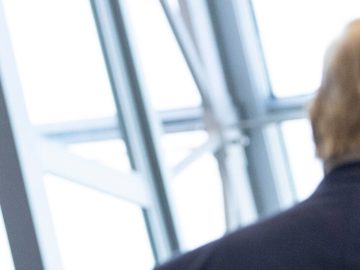Media companies say they want to grow their younger audiences. So, why aren’t executives making more of a concerted effort to lean on that same generation for guidance on how to reach that audience?
Earlier this year, I attended an industry conference event in San Francisco where leading executives from the fields of advertising, marketing, broadcasting and streaming came together to exchange thoughts and ideas on how their industries are converging and where things are headed next.
One of the presenting panelists was Jasmin Corley, a 20-something billed as a “social media influencer” who, in fact, has spent the formative years of her young life establishing and building her own fashion and beauty media brand across social video platforms. Hundreds of thousands of people follow Corley across Instagram, YouTube Shorts and TikTok. Her best-performing clips have north of 1 million views — not an easy thing for anyone to pull off.
Corley shared the stage with executives who hailed from a leading electronics company, a television start-up and an advertising manager from a streaming-focused joint venture. Each of those panelists got more time to speak than she did. In fact, even the moderator — a well-known former reporter for an entertainment trade publication who now covers the free streaming space for a media research company — spoke more than Corley did.
She was asked just two questions, one from the moderator, one from a panelist who sought validation in his own product. The tone seemed to be this: Corley was lucky to share a stage with such esteemed executives in the media and advertising industry. Really, though, they were lucky to share a stage with her. Ultimately, it was a lost opportunity to hear from someone who not only reaches the younger generation on a regular basis, but who walks among them, too.
The same old management
If Corley was frustrated by the experience, she didn’t show it. She graciously exited the stage and went home. I wish I had been as graceful in my 20s. When I was hired to oversee digital initiatives for a Tribune Media-owned newsroom in 2008, I was a baby-faced 21-year-old who was still in college. I thought the company was hiring me for my ideas. Over time, I came to realize they brought me on because I could do a lot of work quickly. And they didn’t have to pay me very much to do it.
Every week, the station assembled different department heads for a meeting. In my first few meetings, I said nothing, though I had a lot of thoughts. Eventually, I spoke up, but it seemed like things were always being shot down. Conversations usually ended with the message that “it isn’t the way we do things here,” or “things are done for a reason,” something along those lines. The meetings did little to accomplish anything, except that everyone seemed annoyed with me toward the end. It was mutual. They mistook my confidence for arrogance; I mistook their arrogance for incompetence.
Times change but too many things stay the same
Perhaps if all sides had gone in with more of an open mind, things would have been different. Back then, media companies had very little to lose — traditional platforms were doing as well, if not better, than emerging digital ones. Today, the opposite is clearly true. Traditional platforms like broadcast radio and television are struggling to address a downturn in their advertising businesses. Meanwhile, next-generation platforms like TikTok, YouTube and Instagram seem to have more money than they know what to do with.
The reasons are numerous, and not too hard to understand. Take TV, for instance. While traditional TV still frames itself around a 30-minute or 1-hour episode, content creators on YouTube or Instagram can go as long as they want, unencumbered by schedules or time limits. They can 30-second clips three times a day, or a 30-minute tutorial twice a month, or any combination or variation in-between. While traditional TV might require a fully-developed script or outline, along with numerous pitch meetings and ad sales justifications, young people can simply grab their phone and create whatever they want to bring into the world.
The proliferation of tablets and smartphones, coupled with the abundance of social video platforms, has lowered the barrier of entry for content creation and distribution. No one understands this better than the generation who grew up with a mature Internet and digital toolset capable of handling those things. And they are taking full advantage of it.
The end result is highly-engaging content that connects with younger consumers, and influences them in many ways, including purchase intentions. A survey by Nerds Collective as reported in The Drum found that 45% of young Europeans who identify as Generation Z “want brands they’ve seen an influencer or celebrity wear,” while just 18% say they’re influenced by what their friends wear.
Young people turn to TikTok
Fashion is one thing. News and information is another. But similar trends apply. Young people are increasingly turning to TikTok and Instagram over Google to find things online (and, to be honest, you can’t really blame them, because Google is a hot mess). When it comes to news and current events, younger audiences are gravitating toward unfiltered personalities and curated experiences that podcasters like comedian Joe Rogan, radio host James O’Brien and French YouTube channel Hugo Décrype offer.
Why is this happening? Over the past few months, I’ve reached out to a number of key figures in media and entertainment to find out. Three executives told me they had to run things up the chain before they could speak with me — suggesting corporate bureaucracy has changed little since I worked in that TV newsroom all those years ago. I managed to secure interviews with three others. But it seemed that they either didn’t understand the situation or could only offer answers that didn’t address the issue at hand.
Change in strategy
I spent more than a month doing precisely the wrong thing: Trying to secure interviews with people with nice executive titles at well-established places, but whose businesses embody many of the problems that this column is trying to address. About two weeks ago, it finally occurred to me that I needed to reach someone who wasn’t involved in media and entertainment, but who spends a lot of time thinking and writing about these problems: Charles Benaiah.
Like me, Benaiah spent his early career working for established media brands before venturing out onto his own. Today, his job as the CEO of Watzan is to observe the landscape and dream up ways for it to improve.
“There are decades of ingrained expectations that are going to have to change,” Benaiah told me in an interview, after I filled him in on the above issues. “It’s not going to change quickly.”
Benaiah agrees that one way to attract and engage younger consumers is to create content that resonates with them. To do so requires hiring young people into key decision-making roles. It also means allowing personality to bubble through. He likens it to the better days of the newspaper industry, where someone might pick up a copy of the daily edition to read the latest clip from their favorite columnist. In the process, they have to flip through several pages of news, and might stop on a story here or there that is connected to, but otherwise separate from, the editorial section.
These days, the editorial page is X, the platform formerly known as Twitter. “We’re 25 years into social media, and I’ve always looked at Twitter as being the social media place for journalists,” Benaiah remarked. “Journalists are writing somewhat dry stories, because that’s what they’re asked to do. They’ve got these great, brilliant quips, and they toss them out all day, but they don’t work their way back into the personality of the newsroom — they make their way onto Twitter.”
Personality and connections
Newsrooms didn’t have a chance to embrace the idea of Twitter before young journalists gravitated to the platform on their own. Once news organizations saw that young journalists could attract a blockbuster following on the platform, they encouraged their reporters to link to their stories, as a way to drive traffic to their website.
The growing pains came when journalists really started to stretch out and let loose on Twitter. Controversies followed. Suddenly, a reporter’s off-hand remark or poorly-landed joke became fodder for another reporter’s mini exposé. Newsrooms that had never developed a framework of acceptable use and best social media practices suddenly found themselves cleaning up a lot of messes.
Some news organizations handled that better than others. However, for the most part, the industry really struggled to find an appropriate balance between giving young journalists the freedom to be themselves on a public platform and applying standards and ethics policies in a non-constraining way.
Striking that balance is important, Benaiah says, because newsrooms that are too rigid risk losing authoritative voices, many of which are deeply engaged with younger audiences. But a free-for-all is also problematic, because authority in news requires trust, and to be trust-worthy, one must be honest and believable.
Supporting young leaders
Young journalists can build authority and trust by being mentored by industry veterans who impart the best practices while embracing the idea that the way things have traditionally been done might not be the best way of doing things in the future. It won’t keep a young journalist from making mistakes, but a guiding hand can encourage them that it isn’t the end of the world. The payoff for giving emerging reporters the space to be themselves and the guidance to be accurate and reliable will be recognized in the long term, in a way that benefits both individual brands and companies at large.

Likewise, media companies that want to reach younger audiences have to hire young people into leadership roles and allow them to be an integral part in content creation and audience engagement strategies. That is the first step, and it is a substantial one. Not engaging young professionals as part of the process is a bit like asking someone who speaks English to create a product slogan in Greek. It makes no sense, yet this is what corporate America has done for years. It is not a winning formula.
At the industry conference I attended earlier this year, everyone in the room should have been clamoring to give Corley their card. They should have asked if she was willing to be a brand ambassador, to help put their product or service or company in front of her audience. They should have asked her for a little insight into the secret sauce that makes her content so tastefully appealing to thousands of viewers.
But no one did. Not that it mattered much to Corley. She went home, and immediately started working on her next project: The “Fr$h Editing Bootcamp.” Over the course of 30 days, Corley educated her followers on the best ways to make short-form videos really pop on social platforms. To date, those videos have amassed tens of thousands of views, and likely influenced the next batch of content creators. It is tough to predict what platforms those videos will live on in 5, 10, 20 years — but if traditional media companies are smart, they’ll do whatever it takes to bring those content creators in before they’re left in the dust.





